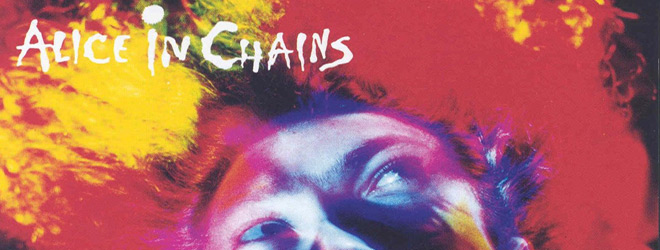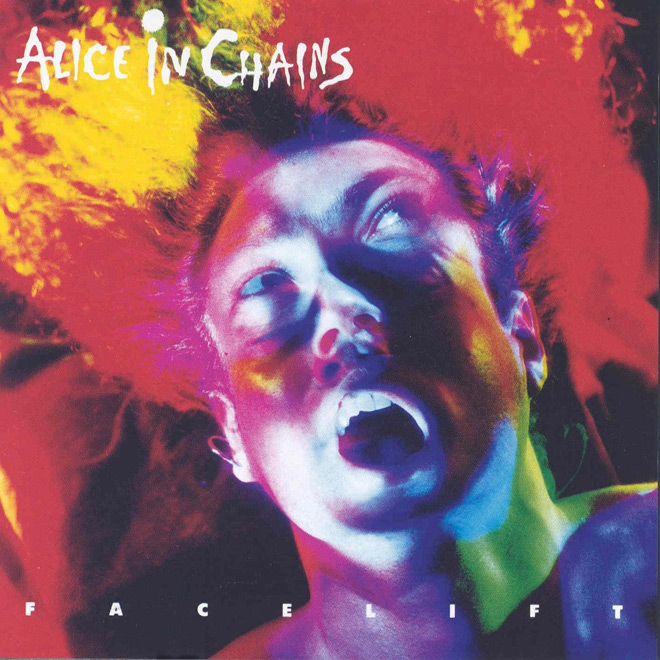While the Grunge movement had set down its roots in the mid-1980s, it would not be until 1991 that the ‘Seattle sound’ would become commercially viable thanks to releases such as Nirvana’s Nevermind, Stone Temple Pilots’ Core, Soundgarden’s Badmotorfinger, and Pearl Jam’s Ten. So in 1990, an amazing new band coming out of Seattle, Washington was not yet commonplace. But arise from the city’s streets many did, and on Tuesday, August 21, 1990, an unknown group named Alice in Chains helped to pioneer the way for many of their contemporaries when they served up their epic debut LP, Facelift.
Formed in 1987, Alice in Chains then consisted of Vocalist Layne Staley, Guitarist/Vocalist Jerry Cantrell, Bassist Mike Starr, and Drummer Sean Kinney. With a more Metal-influenced sound than many of the bands that would follow them out of the Evergreen State, the quartet had a heavy bite to their approach and, with time, began to inject their material with further layers of Staley and Cantrell’s flawless harmonies, along with a grittier, often swampy feel.
For many, they will forever be the men inside the box created by Facelift’s first mega-single, “Man in the Box.” However, there was no instant success for Alice in Chains. In fact, when the LP hit shelves in August 1990, it sold under 40,000 copies in its first six months. It would be thanks to the aforementioned single that the band eventually made it to heavy daytime rotation on MTV (remember when they cared about music?), which catapulted album sales. “Man in the Box” would hit No. 18 on the Mainstream Rock charts, driving the album to peak at No. 42 on the Billboard 200 chart in the summer of 1991.
It was indeed a slow rise toward the top for the band, but we’re getting ahead of ourselves. On August 21, 1990, Facelift arrived thanks to Columbia Records. Produced by Dave Jerden (Anthrax, Jane’s Addiction), the 12-song disc presented a young band who combined Alternative Rock and Heavy Metal into something that would become known as “Grunge,” and yet it was a sound that was more melodic than their Punk Rock-influenced cousins in Nirvana. Topically, they explored love, death, and addiction, a theme that would continue throughout many of their earlier releases as the band members struggled personally.
They kicked the album off with “We Die Young,” touching on one of their popular lyrical themes as Staley offered up his incomparable lead vocals. A track that has gone on to be covered by the likes of Stone Sour and Cane Hill, it had preceded the release of Facelift when Columbia Records issued the We Die Young EP in July 1990 ahead of the full-length. But sitting here today, arguably their most well-known track would be the previously detailed “Man in the Box,” which has gone on to be covered by everyone from David Cook to Warrant to Les Claypool’s Duo de Twang. While its video certainly doesn’t hold up thirty years later, the song will forever be a beloved classic in the annals of heavy music and that ambiguous ‘Seattle sound.’
Throughout the entirety of Facelift, Alice in Chains proudly displayed their sonic diversity—from the bluesy “Sea of Sorrow” to that sultry and swampy vibe that would adorn much of their future work, but initially appeared on tracks such as the album’s closer, “Real Thing.” They (sonically) echoed back to “Man in the Box” on the languid “I Can’t Remember,” explored the complications of love on “Love, Hate, Love,” and went for larger than life guitars on “Sunshine,” where Outlaw Country tangoed with Metal. And there were of course the songs that danced with addiction (“Put You Down”), soaring melodies from Staley and Cantrell (“Confusion”), and straightforward rockers like “I Know Somethin’ (Bout You).”
Facelift established Alice in Chains as a prominent name leading a burgeoning scene, but it also spotlighted the mastery of the band’s craft. Cantrell amalgamated a zillion influences into his performance, offering bluesy and soulful, sometimes psychedelic, complements to Staley’s pained and gritty bellows. As a quartet, they were crunchy, they stomped and they could groove, but they also understood melody. In 1990, it seemed that Alice in Chains could easily go on to rule the world—and they did. For a time.
Since the time of its debut, Facelift has gone on to reach 2x Platinum status. The first Grunge album to be certified Gold by the RIAA, its release set the wheels in motion for Alice in Chains, a band who have been to hell and back—but they have persevered. Indeed, a lot has happened over the past three decades: they’ve gone on to release an additional five albums, two with Staley on vocals—1992’s Dirt and 1995’s Alice in Chains—before his untimely death on April 5, 2002. And though he had left the fold in 1993, former bassist Starr also passed away far too young on March 8, 2011.
Although time cannot heal every single wound, it has been reasonably good to both Cantrell and Kinney, who are still going strong today. Joined by bassist Mike Inez in 1993, in 2006 the three musketeers brought the exceptional William DuVall in to courageously fill the vocal slot. With their lineup intact and going strong for the past 14 years, Alice in Chains has gone on to author an additional three LPs—2009’s Black Gives Way to Blue, 2013’s The Devil Put Dinosaurs Here, and 2018’s Rainier Fog.
With over 30 million records sold worldwide to date, no one would argue that the Grammy Award-nominated Alice in Chains has a storied career in music. Constantly listed as a favorite live band, respected by their peers—Ozzy Osbourne and Soundgarden’s Kim Thayil have listed them among the best of the best—and continuing to influence new generations of rockers—including KoЯn, Breaking Benjamin, In Flames, Incubus, and many more—the story of a little band out of Seattle officially began three decades ago with Facelift.

Alice in Chains Celebrates 30 Years of Facelift
Category(s)Album RetrospectivesCryptic RockCrypticRockNews
Tags1990 album1990 music2x Platinum30th anniversaryaddictionAlbum AnniversaryAlbum RetrospectiveAlice In ChainsAlt MetalAlternative RockAugust 21 1990Bleed The Freakcolumbia recordsConfusionDave JerdenDeathFaceliftfirst Grunge album to go goldGrammy Award nominatedGrungeI Can't RememberI Know Somethin (Bout You)Jerry CantrellLayne StaleyLoveLove Hate LoveMan in the BoxmetalMike Starrmusic anniversaryPut You DownReal ThingSea of SorrowSean KinneySeattleSunshineWe Die Young
Related Articles
Comments are disabled.




